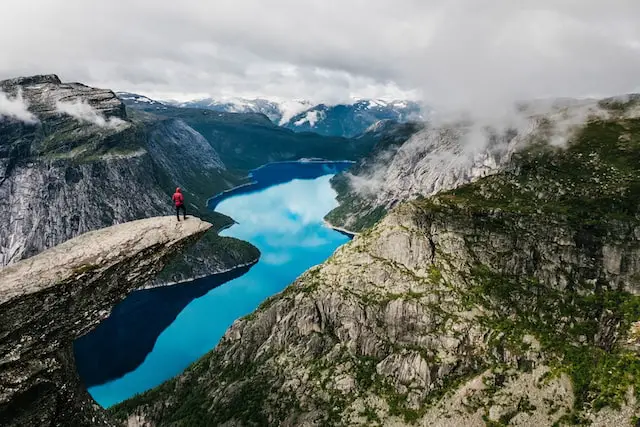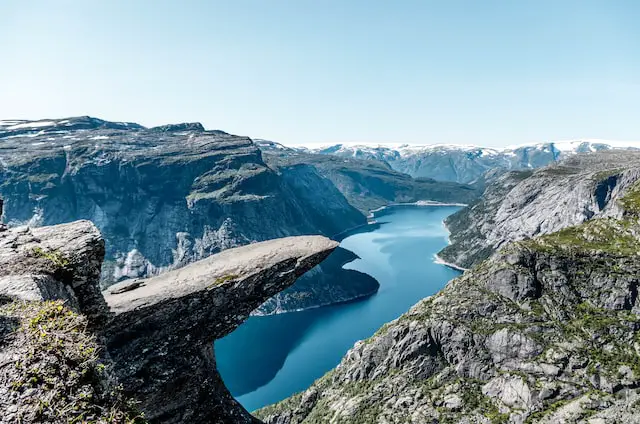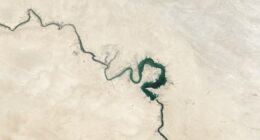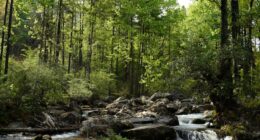Fjords are usually much deeper than rivers, with a steep valley cut by glaciers and often leading to the ocean. Rivers on the other hand tend to be shallower and meander through valleys before joining larger bodies of water like lakes or oceans. Both fjords and rivers can provide stunning views as well as valuable resources for those who inhabit their banks.
What is a fjord?
(Photo by Robert Bye on Unsplash )

A fjord is a long, narrow, deep inlet of the sea that is surrounded by steep cliffs or mountains. Fjords are typically formed by glacial erosion, as glaciers carve out deep valleys in the mountains, which are later flooded by rising sea levels. Fjords are most commonly found in Norway, Greenland, Alaska, and other areas with high latitudes and rugged coastlines. They are often characterized by their steep sides, calm waters, and stunning natural beauty, which makes them popular destinations for tourists and outdoor enthusiasts.
What is a river?
(Photo by Jon Flobrant on Unsplash )

A river is a natural freshwater flowing body of water that empties into an ocean, lake, or other larger body of water. Rivers are an important part of Earth’s water cycle and are vital to the wellbeing of all life on the planet.
Rivers are formed by the erosion of rocks and soil by moving water. Over time, the moving water wears away at the rocks and soil, shaping them into smaller pieces. The smaller pieces are then carried downstream by the current and deposited in another location.
This process can create a variety of landforms, including canyons, valleys, and plains. The force of the moving water can also create features such as rapids, waterfalls, and meanders.
The size of a river can vary greatly depending on its location. Some rivers, like those in tropical regions, may only be a few feet wide during dry seasons but can swell to hundreds of feet during rainy seasons. Other rivers, like those in mountainous regions, can be much wider and flow more rapidly due to the increased amount of runoff from melting snowpack.
The length of a river also varies depending on its location. Rivers located in flatter terrain tend to meander more and be longer overall than rivers located in steeper terrain. The longest river in the world is the Nile River in Africa which spans over 4,000 miles!
The difference between a fjord and a river
The main difference between a fjord and a river is that a fjord is a deep, narrow inlet of the sea that is typically surrounded by steep cliffs or mountains, while a river is a natural watercourse that flows from higher ground to lower ground, eventually reaching a lake, sea or ocean.
Fjords are typically formed by glacial erosion, whereas rivers are formed by the movement of water over time. Fjords are also usually saltwater bodies of water, while rivers are freshwater.
Additionally, fjords tend to have a more complex and irregular shape compared to rivers, with many bends, inlets and branches. Fjords also tend to be much deeper than rivers and have a more pronounced tidal range, with the water level rising and falling more dramatically in response to the ebb and flow of the tides.
In terms of their ecological importance, both fjords and rivers can support a wide variety of plant and animal life, and can be important habitats for fish, birds and other wildlife. However, because of their unique geological and oceanographic characteristics, fjords tend to support a different range of species than rivers.
The benefits and drawbacks of living near a river
Living near a river can have both benefits and drawbacks. Here are some examples:
Benefits:
- Access to water: Living near a river can provide easy access to water for drinking, bathing, and other household needs. It can also provide opportunities for recreational activities like swimming, fishing, and boating.
- Fertile soil: Rivers often deposit nutrient-rich sediment along their banks, making the soil in the surrounding areas particularly fertile. This can be ideal for growing crops and other vegetation.
- Scenic beauty: Many people find living near a river to be aesthetically pleasing, as it can provide scenic views and a sense of tranquility.
Drawbacks:
- Flooding: Living near a river can put you at risk of flooding during periods of heavy rainfall or snowmelt. This can cause damage to your property and put your safety at risk.
- Erosion: Over time, rivers can erode the land around them, which can lead to soil instability and landslides.
- Pollution: Rivers can be sources of pollution, particularly if they are downstream from industrial or agricultural areas. This can pose a risk to human health and the environment.
- Mosquitoes and other pests: Living near a river can provide a breeding ground for mosquitoes and other pests, which can be a nuisance and potentially carry diseases.
Overall, living near a river can be beneficial for those who enjoy the natural beauty and recreational opportunities it provides, but it is important to be aware of the potential risks and drawbacks as well. Proper planning and precautions can help mitigate some of these risks and allow for a safe and enjoyable riverfront living experience.
The benefits and drawbacks of living near a fjord
Living near a fjord can have both benefits and drawbacks. Here are some examples:
Benefits:
- Scenic beauty: Fjords are known for their breathtaking natural beauty, with steep cliffs, clear waters, and often snow-capped mountains in the background. Living near a fjord can provide stunning views and a sense of tranquility.
- Recreational opportunities: Fjords can provide opportunities for a variety of outdoor activities such as hiking, boating, fishing, and kayaking.
- Wildlife: Fjords can be important habitats for a variety of plant and animal species, including whales, seals, and sea birds, which can make for interesting and unique wildlife viewing opportunities.
Drawbacks:
- High cost of living: Living near a fjord can be expensive, as waterfront properties often command a premium price.
- Remote location: Fjords are often located in more remote areas, which can make accessing basic services like healthcare and groceries more challenging.
- Weather: Fjords can experience harsh weather conditions, including strong winds, heavy rains, and snowfall, which can be challenging to live in.
- Limited job opportunities: Remote fjord locations may have limited job opportunities, which can make finding employment a challenge.
Overall, living near a fjord can be a desirable lifestyle choice for those who appreciate natural beauty and outdoor activities. However, it is important to be aware of the potential challenges that come with living in a remote location and in a region with potentially harsh weather conditions.
Why is it called a fjord?
Fjords are called fjords because they are formed by glaciers. A fjord is a narrow inlet of the sea bordered by steep cliffs, typically formed by glacial erosion. River valleys can also be cut by glaciers, but usually to a much lesser degree than fjords.
How deep is the water in the fjords?
The average depth of the water in a fjord is about 1,000 feet, but the depth can vary depending on the particular fjord. The deepest fjord in the world is Hoy Sound in Scotland, which has a maximum depth of 4,400 feet.
Which country has the most fjords?
The longest and deepest fjord in the world is Scoresby Sund in Greenland. It is approximately 350km long and has a maximum depth of 1,600m. The second longest fjord is Sognefjord in Norway, which is 204km long with a maximum depth of 1,308m. The third longest fjord is Hardangerfjord in Norway, which is 179km long with a maximum depth of 914m.
There are many other notable fjords around the world including Milford Sound in New Zealand, Doubtful Sound in New Zealand, geirangerfjord in Norway, etc.
Why is fjord water green?
Fjord water can appear green for a variety of reasons, depending on the specific fjord and the conditions present. Here are a few possible explanations:
- Phytoplankton: Fjords can be rich in nutrients, including nitrogen and phosphorus, which can support the growth of microscopic plants called phytoplankton. These plants are green in color due to the presence of chlorophyll, which they use to convert sunlight into energy through photosynthesis. In areas with high concentrations of phytoplankton, the water can appear green in color.
- Glacial silt: Fjords are often formed by glacial activity, and glaciers can grind rocks and other materials into fine particles called glacial silt. This silt can be carried by meltwater into the fjord, where it can make the water appear greenish or cloudy.
- Algae: Some types of algae can also contribute to the green color of fjord water. These algae are similar to phytoplankton in that they use chlorophyll to convert sunlight into energy. However, they are larger and more visible than phytoplankton, and can sometimes form large mats or blooms on the water’s surface.
Overall, the green color of fjord water is typically caused by some combination of these factors, and can vary depending on the season, weather conditions, and other variables.
Which country has the most rivers?
There are many rivers in the world, and it is difficult to say which country has the most. Depending on how you measure river length, different countries could be at the top of the list. For example, if you measure by the total length of all rivers in a country, then Russia would be at the top of the list. If you measure by the average length of rivers in a country, then China would be at the top.
There are also many different types of rivers, so it is hard to make a definitive comparison. Some rivers are very long but relatively shallow, while others are shorter but much deeper. Some rivers flow slowly, while others flow very quickly. So, there is no single answer to the question of which country has the most rivers.
What is the longest river in the world?
The longest river in the world is the Nile, which stretches for over 4,000 miles from its sources in Sudan and Ethiopia to its mouth in Egypt. The Amazon is a close second, winding for over 3,900 miles through Brazil, Peru, and Colombia. Other major rivers include the Yangtze (3,915 miles) in China, the Mississippi (2,340 miles) in the United States, and the Yenisei (2,167 miles) in Russia.
Can you swim in a fjord?
Fjords are long, narrow inlets of the sea bordered by steep cliffs. Rivers are freshwater streams that flow into larger bodies of water such as lakes or the ocean. You can swim in both a fjord and a river, but the water in a fjord is usually colder because it is fed by melting glaciers.
Featured Image By – Photo by Dong Zhang on Unsplash








